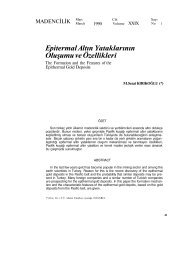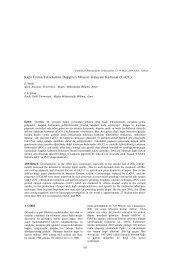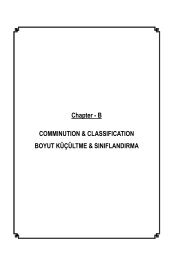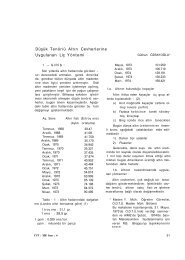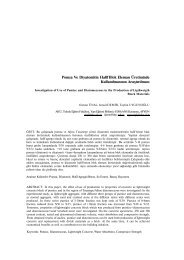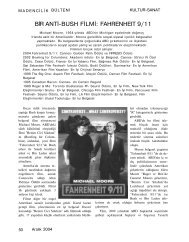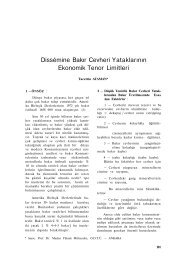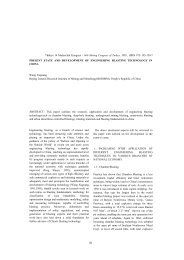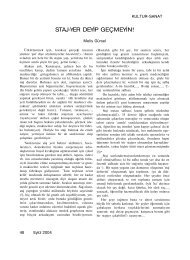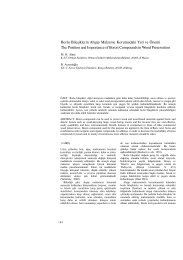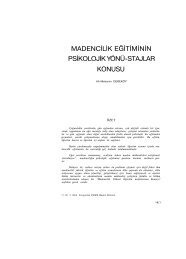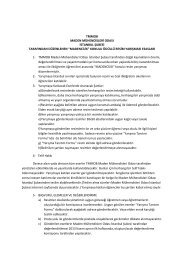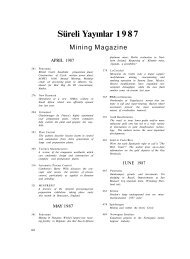A OPEN PIT MINING AÇIK OCAK MADENCİLİĞİ
A OPEN PIT MINING AÇIK OCAK MADENCİLİĞİ
A OPEN PIT MINING AÇIK OCAK MADENCİLİĞİ
You also want an ePaper? Increase the reach of your titles
YUMPU automatically turns print PDFs into web optimized ePapers that Google loves.
analisys degradation and erosion risk<br />
mapping in a GIS environment, but also the<br />
evolution of degradation of landforms.<br />
The successfull applications of unmanned<br />
aerial vehicle (UAV) in the field of closerange<br />
photogrammetry (Neitzel et al. 2011)<br />
on abandoned mine areas have encouraged<br />
the development of new methods for rapid<br />
low-altitude image survey (from a few<br />
meters to a max. of 80 meters of altitude).<br />
With a GPS basis grid, acquired with<br />
accuracy below the meter, the UAV<br />
photogrammetry platform equipped with<br />
SLR high-resolution digital camera is<br />
capable of performing a very accurate<br />
photogrammetric data acquisition.<br />
However, this accuracy is not sufficient<br />
for the geoprocessing computations that<br />
need, besides the GPS flight log, the<br />
acquisition of ground planimetric and<br />
altimetric ground control points (GCP)<br />
coordinates using a real-time kinematic GPS<br />
(RTK-GPS).<br />
The processing of aerial photographs was<br />
performed with the PhotoScan software<br />
(AgiSoft LLC), particularly suitable for<br />
photogrammetric survey of morphologically<br />
complex surfaces (Verhoeven 2011).<br />
The photogrammetric method proposed<br />
in this work is based on several missions<br />
(flight and data acquisition) planned in the<br />
lab with dedicated software, starting from<br />
the area of interest (AOI) and the required<br />
ground sample distance (GSD), knowing the<br />
parameters of the digital camera. The<br />
photogrammetric acquisitions was performed<br />
both by horizontal and vertical planes data<br />
acquisition, needed to the generation of<br />
orthophotos, DEMs and 3D objects.<br />
2 STUDY AREA AND GEOLOGICAL<br />
SETTING<br />
The studied area covers about one square<br />
km near the Monte Porceddu, between the<br />
basins of Rio S'Alluminu and Rio Maccioni.<br />
This abandoned mining area offers wide<br />
artificial landscape landforms that show<br />
several geometrical complexities (Fig. 1). It<br />
is characterized by several quarries with high<br />
vertical wall, stratified with layers affected<br />
by hydrothermal and intermediate to<br />
advanced argillic alteration and<br />
silicification.<br />
This study if focused, at the moment, on<br />
the northern area of the Monte Porceddu<br />
mine (AOI, Fig. 2), where the argillic<br />
alteration is characterized by kaolinite and<br />
dickite as main minerals, accompanied by<br />
quartz, pyrite and pyrophyllite. This<br />
alteration involves the complete<br />
transformation of the pre-existing andesitic<br />
rock, with obliteration of the particular<br />
former textures.<br />
The ore grade kaolin occurrences coincide<br />
with areas where the advanced argillic<br />
alteration reached a pervasive level: this<br />
happened especially where the original rocks<br />
were very permeable, thus exposed to<br />
etching by acid solutions. The kaolinized<br />
bodies have been no longer exploited<br />
because of low quality of the ore which is<br />
too rich in silica and pyrite. The silicification<br />
type is due to deposition of mobilized silica,<br />
both as impregnation of volcanic and<br />
volcano-sedimentary rocks and as crusts. In<br />
fact, a broadly tabular, flat-lying crops on<br />
the top of Monte Porceddu overlies the<br />
kaolinized area. This silica body is<br />
characterized by the occurrence of<br />
chalcedony and small shallow-seated<br />
eruption breccias. All these features suggest<br />
that this may be a silica cup, formed in the<br />
surficial part of the epithermal system, above<br />
the water table, by acidic and relatively cool<br />
steam-heated fluids. The silicification<br />
alteration occurs also at the contacts between<br />
andesitic domes and the epiclasticpyroclastics<br />
units. Within the latter, the<br />
intensity of silicification is also controlled<br />
by the permeability of the layers. The<br />
distribution of silicic alteration suggests that<br />
hydrothermal fluid flows channeled<br />
preferentially along lithological contacts.<br />
A complete understanding of the<br />
geological structures in relationship with<br />
degradation landforms, derived by past<br />
mining activities, is the most important<br />
factor to define the different consistent<br />
resolution of DEMs and the appropriate<br />
scale for planning the photogrammetric<br />
survey of this area.<br />
84



